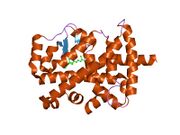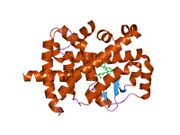Biology:RAR-related orphan receptor beta
 Generic protein structure example |
RAR-related orphan receptor beta (ROR-beta), also known as NR1F2 (nuclear receptor subfamily 1, group F, member 2) is a nuclear receptor that in humans is encoded by the RORB gene.[1]
Function
The protein encoded by this gene is a member of the NR1 subfamily of nuclear hormone receptors. It is a DNA-binding protein that can bind as a monomer or as a homodimer to hormone response elements upstream of several genes to enhance the expression of those genes. The specific functions of this protein are not known, but it has been shown to interact with NM23-2, a nucleoside-diphosphate kinase involved in organogenesis and differentiation.[2]
In the brain, ROR-beta is concentrated in layer 4 of the cerebral cortex, where it plays a role in the development of structures such as barrel columns.[3]
A mutation in this gene also results in the loss of spinal cord interneurons and of saltatorial locomotion,[4] a type of hopping gait that in mammals can be found in rabbits, hares, kangaroos, and some species of rodents.
Interactions
RAR-related orphan receptor beta has been shown to interact with NME1.[5]
See also
References
- ↑ "Isoform-specific amino-terminal domains dictate DNA-binding properties of ROR alpha, a novel family of orphan hormone nuclear receptors". Genes Dev. 8 (5): 538–53. March 1994. doi:10.1101/gad.8.5.538. PMID 7926749.
- ↑ "Entrez Gene: RORB RAR-related orphan receptor B". https://www.ncbi.nlm.nih.gov/sites/entrez?Db=gene&Cmd=ShowDetailView&TermToSearch=6096.
- ↑ "RORβ induces barrel-like neuronal clusters in the developing neocortex". Cereb. Cortex 22 (5): 996–1006. May 2012. doi:10.1093/cercor/bhr182. PMID 21799210.
- ↑ Carneiro, Miguel; Vieillard, Jennifer; Andrade, Pedro; Boucher, Samuel; Afonso, Sandra; Blanco-Aguiar, José A.; Santos, Nuno; Branco, João et al. (2021). "A loss-of-function mutation in RORB disrupts saltatorial locomotion in rabbits". PLOS Genetics 17 (3): e1009429. doi:10.1371/journal.pgen.1009429. PMID 33764968.
- ↑ "The metastasis suppressor candidate nucleotide diphosphate kinase NM23 specifically interacts with members of the ROR/RZR nuclear orphan receptor subfamily". Biochem. Biophys. Res. Commun. 227 (1): 82–7. October 1996. doi:10.1006/bbrc.1996.1471. PMID 8858107.
Further reading
- "Effect of supplemental zinc on growth and on hair and blood serum levels of beef cattle". J. Anim. Sci. 45 (1): 160–5. 1977. doi:10.2527/jas1977.451160x. PMID 885817.
- "RZRs, a new family of retinoid-related orphan receptors that function as both monomers and homodimers". Mol. Endocrinol. 8 (6): 757–70. 1994. doi:10.1210/mend.8.6.7935491. PMID 7935491.
- "Functional analysis of retinoid Z receptor beta, a brain-specific nuclear orphan receptor". Proc. Natl. Acad. Sci. U.S.A. 93 (19): 10105–10. 1996. doi:10.1073/pnas.93.19.10105. PMID 8816759. Bibcode: 1996PNAS...9310105G.
- "The metastasis suppressor candidate nucleotide diphosphate kinase NM23 specifically interacts with members of the ROR/RZR nuclear orphan receptor subfamily". Biochem. Biophys. Res. Commun. 227 (1): 82–7. 1996. doi:10.1006/bbrc.1996.1471. PMID 8858107.
- "Normalization and subtraction: two approaches to facilitate gene discovery". Genome Res. 6 (9): 791–806. 1996. doi:10.1101/gr.6.9.791. PMID 8889548.
- "Developmental expression of 'RZR beta, a putative nuclear-melatonin receptor' mRNA in the suprachiasmatic nucleus of the rat". Neurosci. Lett. 217 (1): 17–20. 1996. doi:10.1016/S0304-3940(96)13060-3. PMID 8905729.
- "Disruption of retinoid-related orphan receptor beta changes circadian behavior, causes retinal degeneration and leads to vacillans phenotype in mice". EMBO J. 17 (14): 3867–77. 1998. doi:10.1093/emboj/17.14.3867. PMID 9670004.
- "Differential ligand-dependent protein-protein interactions between nuclear receptors and a neuronal-specific cofactor". Proc. Natl. Acad. Sci. U.S.A. 97 (13): 7160–5. 2000. doi:10.1073/pnas.97.13.7160. PMID 10860982. Bibcode: 2000PNAS...97.7160G.
- "Differential binding and transcriptional behaviour of two highly related orphan receptors, ROR alpha(4) and ROR beta(1)". Biochim. Biophys. Acta 1494 (3): 236–41. 2000. doi:10.1016/s0167-4781(00)00237-2. PMID 11121580.
- "Differential transcription of the orphan receptor RORbeta in nuclear extracts derived from Neuro2A and HeLa cells". Nucleic Acids Res. 29 (16): 3424–32. 2001. doi:10.1093/nar/29.16.3424. PMID 11504880.
- "X-ray structure of the orphan nuclear receptor RORbeta ligand-binding domain in the active conformation". EMBO J. 20 (21): 5822–31. 2001. doi:10.1093/emboj/20.21.5822. PMID 11689423.
- "Rhythmic expression of ROR beta mRNA in the mice suprachiasmatic nucleus". Neurosci. Lett. 320 (1–2): 13–6. 2002. doi:10.1016/S0304-3940(02)00011-3. PMID 11849752.
- "All-trans retinoic acid is a ligand for the orphan nuclear receptor ROR beta". Nat. Struct. Biol. 10 (10): 820–5. 2003. doi:10.1038/nsb979. PMID 12958591.
External links
- orphan+nuclear+receptor+ROR-beta at the US National Library of Medicine Medical Subject Headings (MeSH)
Template:Receptor/signaling modulators
 |




